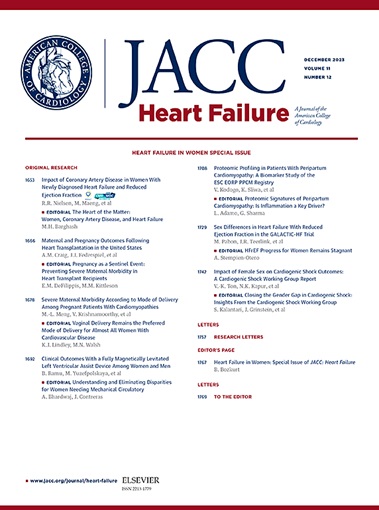The Association of Echocardiographically Measured Donor Left Ventricular Mass and 1-Year Outcomes After Heart Transplantation
IF 10.3
1区 医学
Q1 CARDIAC & CARDIOVASCULAR SYSTEMS
引用次数: 0
Abstract
Background
Donor-recipient heart size matching is crucial in heart transplantation; however, the often-used predicted heart mass (PHM) ratio may be inaccurate in the setting of obesity.
Objectives
In this study, the authors sought to investigate the association between echocardiographically measured donor left ventricular mass (LVM) for heart size matching and the risk of the primary 1-year composite outcome of death or retransplantation.
Methods
The Donor Heart Study was a prospective, multicenter, observational cohort study that collected echocardiograms from brain-dead donors. The measured LVM ratio (donor measured LVM/recipient predicted LVM) was defined as the exposure variable, and the association with the primary outcome was analyzed with Cox proportional hazard modeling. Secondary analyses evaluated the association of the PHM and predicted LVM (donor predicted LVM/recipient predicted LVM) ratios with the primary outcome.
Results
In 2,015 heart transplants, the measured LVM ratio demonstrated that undersized matches (<0.80) had a 47% higher risk (adjusted HR [aHR]: 1.47; 95% CI: 1.01-2.15) and oversized (>1.20) matches had a 58% increased risk (aHR: 1.58; 95% CI: 1.05-2.37) of the 1-year composite outcome compared with ideally matched transplants. However, the PHM and predicted LVM ratios were not associated with the primary outcome. Nonlinear modeling demonstrated a U-shaped relationship between the measured LVM ratio and composite outcome. The measured LVM ratio had superior predictive power for poor post-transplantation outcomes in obese recipients.
Conclusions
Measuring donor LVM with the use of echocardiography may provide a more accurate method for donor-recipient heart size matching that could improve heart transplant outcomes, especially in obese recipients.
超声心动图测量的供体左心室质量与心脏移植术后 1 年预后的关系
背景:在心脏移植手术中,供体与受体的心脏大小匹配至关重要:供体-受体心脏大小匹配在心脏移植中至关重要;然而,经常使用的预测心脏质量(PHM)比值在肥胖的情况下可能并不准确:在这项研究中,作者试图调查用于心脏大小匹配的超声心动图测量的供体左心室质量(LVM)与1年主要综合结果(死亡或再移植)风险之间的关系:捐献者心脏研究是一项前瞻性、多中心、观察性队列研究,收集了脑死亡捐献者的超声心动图。测量的左心室容积比(捐献者测量的左心室容积/受者预测的左心室容积)被定义为暴露变量,其与主要结果的关系采用 Cox 比例危险模型进行分析。次要分析评估了 PHM 和预测 LVM(供体预测 LVM/受体预测 LVM)比率与主要结果的关系:结果:在 2,015 例心脏移植中,测量的 LVM 比值显示,与匹配度理想的移植相比,匹配度不足(1.20)的移植出现 1 年综合结果的风险增加了 58%(aHR:1.58;95% CI:1.05-2.37)。然而,PHM 和预测 LVM 比率与主要结果无关。非线性模型显示,测量的左心室容积比与综合结果之间呈 U 型关系。测量的左心室容积比对肥胖受者移植后不良预后的预测能力更强:结论:使用超声心动图测量供体左心室容积可为供体和受体心脏大小匹配提供更准确的方法,从而改善心脏移植的预后,尤其是肥胖受体的预后。
本文章由计算机程序翻译,如有差异,请以英文原文为准。
求助全文
约1分钟内获得全文
求助全文
来源期刊

JACC. Heart failure
CARDIAC & CARDIOVASCULAR SYSTEMS-
CiteScore
21.20
自引率
2.30%
发文量
164
期刊介绍:
JACC: Heart Failure publishes crucial findings on the pathophysiology, diagnosis, treatment, and care of heart failure patients. The goal is to enhance understanding through timely scientific communication on disease, clinical trials, outcomes, and therapeutic advances. The Journal fosters interdisciplinary connections with neuroscience, pulmonary medicine, nephrology, electrophysiology, and surgery related to heart failure. It also covers articles on pharmacogenetics, biomarkers, and metabolomics.
 求助内容:
求助内容: 应助结果提醒方式:
应助结果提醒方式:


